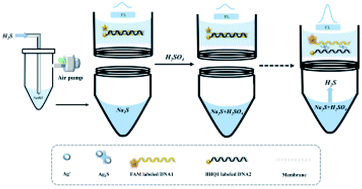A signal-on fluorescence sensor for hydrogen sulphide detection in environmental samples based on silver-mediated base pairs
Abstract
Hydrogen sulfide (H2S) is a dramatically toxic gas molecule; long term exposure to H2S environment poses a serious threat to human health. It is highly imperative to develop sensitive and selective methods for H2S detection. In this study, a signal-on fluorescence biosensor for the H2S (used to represent the total amount of H2S, HS− and S2−) detection was developed based on silver-mediated base pairs (C–Ag+–C). Two separate C-rich single-stranded DNAs (ssDNAs) were synthesized, namely, one was labeled with fluorescein (6-carboxyfluorescein, FAM) and the other was labeled with quencher (black hole quencher, BHQ1). The two ssDNAs were in a flexible single strand owing to the mismatch of the ssDNA, and hence, significant fluorescence intensity was observed. In the presence of Ag+, DNA probes could selectively capture Ag+ to form double stranded DNA (dsDNA) via the C–Ag+–C base pairs, which made the quench of FAM by BHQ1 and low fluorescence signal was detected. With the addition of H2S to the system, the dsDNA was decomposed into ssDNA since Ag+ could be released from C–Ag+–C by the formation of a more stable complex Ag2S, which resulted in the recovery of the fluorescence intensity. The enhanced fluorescence intensity had a linear relationship with H2S concentration in the range from 0.5 to 20 μM with a detection limit (LOD) of 0.16 μM (S/N = 3). The proposed system was applied to detect H2S (used to represent the total amount of H2S, HS− and S2−) in air near a garbage station with satisfying results.



 Please wait while we load your content...
Please wait while we load your content...